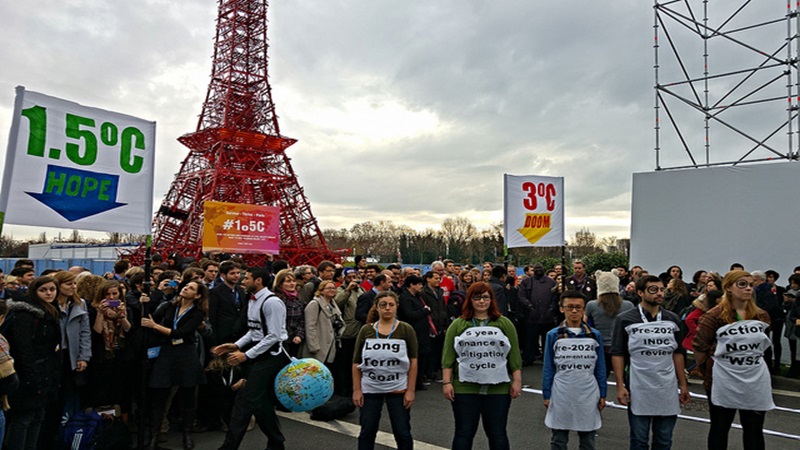
Mariam Omar
Keeping global average temperature below 2°C. Can we reach our goal? Are we on track?
Most Read Stories Today
-
Water Scarcity and Artificial Rainfall: The Positive and The Negative Effects of Cloud Seeding, including Health Hazards and Climate Implications.
-
Renewable Energy in Rural Areas: Challenges, Opportunities, and Successful Rural Projects
-
Bridging the Gulf Between Scientific Knowledge and Public Understanding.
-
South Korea's floods: root causes and prevention strategies.
-
Are African Plants Getting Ignored Amidst the Climate Change?
-
Degenerative Impact of Hydrocarbons On The Environment.
-
Climate Change's Grip on Northern Ghana's Agricultural Landscape.
-
Community-Based Adaptation: Land Management and Fire Prevention Techniques in the Heart of Mexico
-
Negative Impacts of Climate Change on Food Security in South Africa
-
Successes and Failures of Paris Agreement
Limiting global warming to well below 2, preferably to 1.5 degrees Celsius has been a goal since 12 December 2015, as enacted in the Paris agreement. It is considered a landmark in the multilateral climate change process because it brings all nations
Limiting global warming to well below 2, preferably to 1.5 degrees Celsius has been a goal since 12 December 2015 as agreed in the Paris agreement. It is considered a landmark in the multilateral climate change process because it brings all nations into a common cause to undertake ambitious efforts to combat climate change and adapt to its effects. It was adopted by 196 Parties at COP 21 in Paris and became operative on 4 November 2016. Countries aim to achieve this long-term temperature goal by peaking global greenhouse gas emissions as soon as possible in order to achieve a climate-neutral world by mid-century. We already see effects scientists predicted; Glaciers and ice sheets in polar and mountain regions are melting faster than ever before, rising sea levels, almost two-thirds of the world's cities with populations of more than five million are located in areas vulnerable to sea level rise, and nearly 40% of the world's population lives within 100 kilometers of a coast. Many other cities may be submerged within our lifetimes, displacing millions of people. 15,000 people died specifically in 2022 due to heatwave kill. As humans, we face numerous challenges, but we are far from alone in feeling the heat. As land and sea change rapidly, the animals that inhabit them are doomed to extinction. vertebrate species are disappearing at a rate that is more than 100 times faster than the natural rate of extinction due to human-caused climate change, pollution, and deforestation. And here lies the question: can we reach our goal? Are we on track? It is still within our reach theoretically, the world's totemic aim of keeping average global temperature increases to 1.5°C will deteriorate unless humanity makes a significant course correction. In the years since the Paris Agreement went into effect, low-carbon solutions and new markets have emerged. Carbon neutrality targets are being established by an increasing number of countries, regions, cities, and businesses. Zero-carbon solutions are becoming more competitive in economic sectors that account for 25% of emissions. This trend is most visible in the power and transportation sectors, where it has created numerous new business opportunities for early adopters. The most recent climate predictions indicate that global temperature rise will continue, with a chance that one of the years between 2022 and 2026 will exceed 1.5 degrees Celsius above pre-industrial levels, but a single year of exceeding 1.5 °C does not imply that we have breached the iconic Paris Agreement threshold, but it does indicate that we are getting closer to a situation in which 1.5 °C could be exceeded for an extended period of time. To combat climate change, countries must implement truly drastic adaptation and mitigation measures. Adaptation entails preparing health systems and societies for the future. For instance, heat-health action plans are essential to climate change adaptation and safeguard communities from heat-related diseases. Mitigation entails being a part of the solution. Climate-resilient, sustainable, and low-carbon health systems and societies are required. As the world heats up, the risk increases, and if the world does not begin rapidly to reduce emissions, the 1.5C target will be passed sometime between 2026 and 2042. It's time we embrace Change and cooperate to save the planet.



 English
English العربية
العربية Български
Български 简体中文
简体中文 繁體中文
繁體中文 Hrvatski
Hrvatski Čeština
Čeština Dansk
Dansk Nederlands
Nederlands Suomi
Suomi Français
Français Deutsch
Deutsch Ελληνικά
Ελληνικά हिन्दी
हिन्दी Italiano
Italiano 日本語
日本語 한국어
한국어 Norsk bokmål
Norsk bokmål Polski
Polski Português
Português Română
Română Русский
Русский Español
Español Svenska
Svenska Català
Català Filipino
Filipino עִבְרִית
עִבְרִית Bahasa Indonesia
Bahasa Indonesia Latviešu valoda
Latviešu valoda Lietuvių kalba
Lietuvių kalba Српски језик
Српски језик Slovenčina
Slovenčina Slovenščina
Slovenščina Українська
Українська Tiếng Việt
Tiếng Việt Shqip
Shqip Eesti
Eesti Galego
Galego Magyar
Magyar Maltese
Maltese ไทย
ไทย Türkçe
Türkçe فارسی
فارسی Afrikaans
Afrikaans Bahasa Melayu
Bahasa Melayu Kiswahili
Kiswahili Gaeilge
Gaeilge Cymraeg
Cymraeg Беларуская мова
Беларуская мова Íslenska
Íslenska Македонски јазик
Македонски јазик יידיש
יידיש Հայերեն
Հայերեն Azərbaycan dili
Azərbaycan dili Euskara
Euskara ქართული
ქართული Kreyol ayisyen
Kreyol ayisyen اردو
اردو বাংলা
বাংলা Bosanski
Bosanski Cebuano
Cebuano Esperanto
Esperanto ગુજરાતી
ગુજરાતી Harshen Hausa
Harshen Hausa Hmong
Hmong Igbo
Igbo Basa Jawa
Basa Jawa ಕನ್ನಡ
ಕನ್ನಡ ភាសាខ្មែរ
ភាសាខ្មែរ ພາສາລາວ
ພາສາລາວ Latin
Latin Te Reo Māori
Te Reo Māori मराठी
मराठी Монгол
Монгол नेपाली
नेपाली ਪੰਜਾਬੀ
ਪੰਜਾਬੀ Afsoomaali
Afsoomaali தமிழ்
தமிழ் తెలుగు
తెలుగు Yorùbá
Yorùbá Zulu
Zulu ဗမာစာ
ဗမာစာ Chichewa
Chichewa Қазақ тілі
Қазақ тілі Malagasy
Malagasy മലയാളം
മലയാളം සිංහල
සිංහල Sesotho
Sesotho Basa Sunda
Basa Sunda Тоҷикӣ
Тоҷикӣ O‘zbekcha
O‘zbekcha አማርኛ
አማርኛ Corsu
Corsu Ōlelo Hawaiʻi
Ōlelo Hawaiʻi كوردی
كوردی Кыргызча
Кыргызча Lëtzebuergesch
Lëtzebuergesch پښتو
پښتو Samoan
Samoan Gàidhlig
Gàidhlig Shona
Shona سنڌي
سنڌي Frysk
Frysk isiXhosa
isiXhosa
Terms & Conditions
Subscribe
Report
My comments